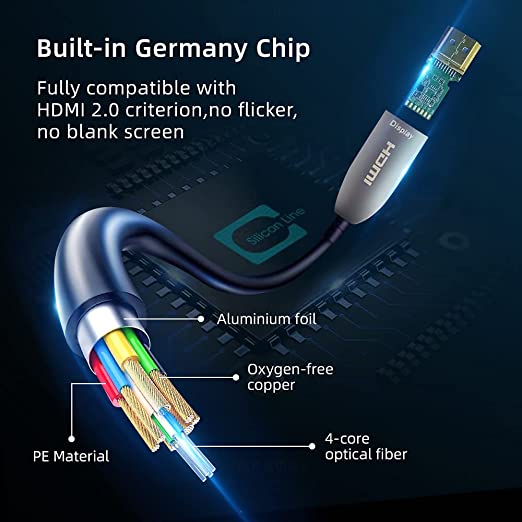Replacement for Basler 2000034891 Premium 8-meter USB 3.0 Camera Link Cable
04/28/2023Optische HDMI kabels: De toekomst van beeld- en geluidsoverdracht
05/04/2023What Is a Fiber Optic HDMI Cable?
HDMI cables have been the go-to standard for high-quality digital audio and video transmission for many years. However, traditional copper HDMI cables have limitations, particularly in terms of distance and signal quality over long distances. This is where fiber optic HDMI cables come in.
Fiber optic HDMI cables, also called AOC HDMI Cable, HDMI Fiber Cable, as the name suggests, use fiber optic technology to transmit audio and video signals. Instead of using copper wires to carry the signals, fiber optic HDMI cables use hybrid optical fibers & copper wires to transmit the signals over long distances with high fidelity and minimal signal loss.
Advantages of Fiber Optic HDMI Cables
The use of fiber optic technology offers several advantages over traditional copper HDMI cables. These advantages include:
- Long-Distance Transmission: Copper HDMI cables are limited in terms of distance, with signal degradation and loss over distances exceeding 50 feet. Fiber optic HDMI cables, on the other hand, can transmit signals over much longer distances, up to 330 feet or more.
- High Fidelity: Fiber optic cables are not susceptible to electromagnetic interference, which can cause signal degradation and distortion. This means that fiber optic HDMI cables can provide high-quality, distortion-free transmission of digital audio and video signals.
- Immunity to Electromagnetic Interference: Fiber optic HDMI cables are immune to electromagnetic interference, making them ideal for use in environments where electromagnetic interference may be a concern, such as hospitals or industrial facilities.
- Future-Proofing: Fiber optic HDMI cables are future-proof, as they are designed to support emerging technologies like 8K and 10K resolutions, higher frame rates, and HDR (High Dynamic Range) video.
Applications of Fiber Optic HDMI Cables
Fiber optic HDMI cables are ideal for a wide range of applications, including:
- Home Theater: Fiber optic HDMI cables can transmit high-quality audio and video signals from your home theater components, including Blu-ray players, game consoles, and cable/satellite boxes.
- Digital Signage: Fiber optic HDMI cables are ideal for use in digital signage installations, where high-quality video signals need to be transmitted over long distances.
- Medical Imaging: Fiber optic HDMI cables are used in medical imaging applications, where high-quality, distortion-free transmission of digital images is critical.
- Industrial Applications: Fiber optic HDMI cables are ideal for use in industrial applications, where electromagnetic interference may be a concern.
Challenges and Solutions
One of the challenges of using fiber optic HDMI cables is that they can be more expensive than traditional copper HDMI cables. However, this cost can be offset by the advantages of fiber optic technology, particularly in terms of long-distance transmission and immunity to electromagnetic interference.
Another potential challenge is compatibility. Fiber optic HDMI cables may not be compatible with all HDMI devices, particularly older devices that were designed to work with traditional copper HDMI cables. However, most modern HDMI devices are designed to work with both copper and fiber optic HDMI cables.
Conclusions
Fiber optic HDMI cables offer significant advantages over traditional copper HDMI cables in terms of distance, signal quality, and immunity to electromagnetic interference. They are ideal for a wide range of applications, including home theater, digital signage, medical imaging, and industrial applications. While there may be some challenges associated with using fiber optic HDMI cables, these challenges can be overcome with careful selection and installation of the cables.

